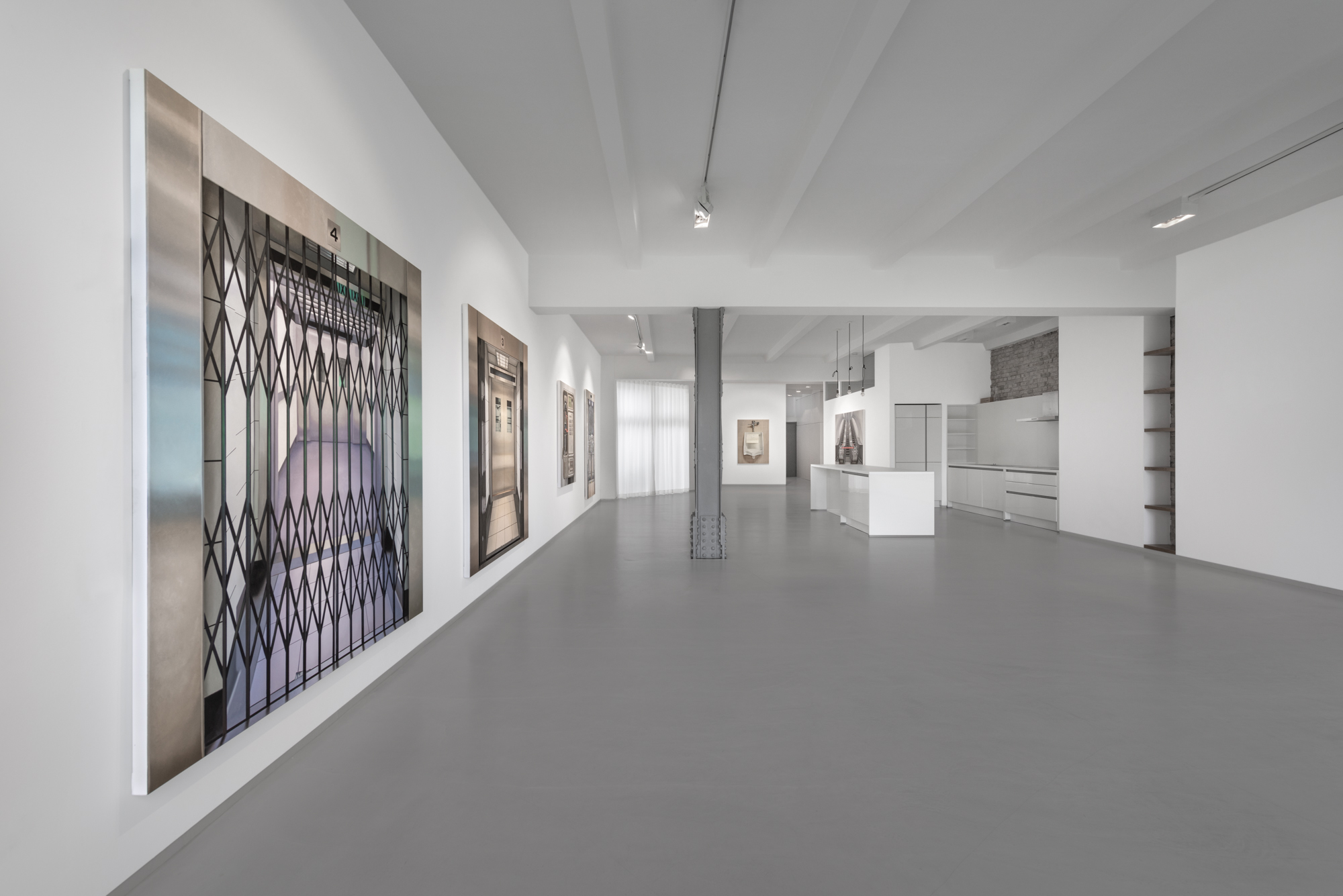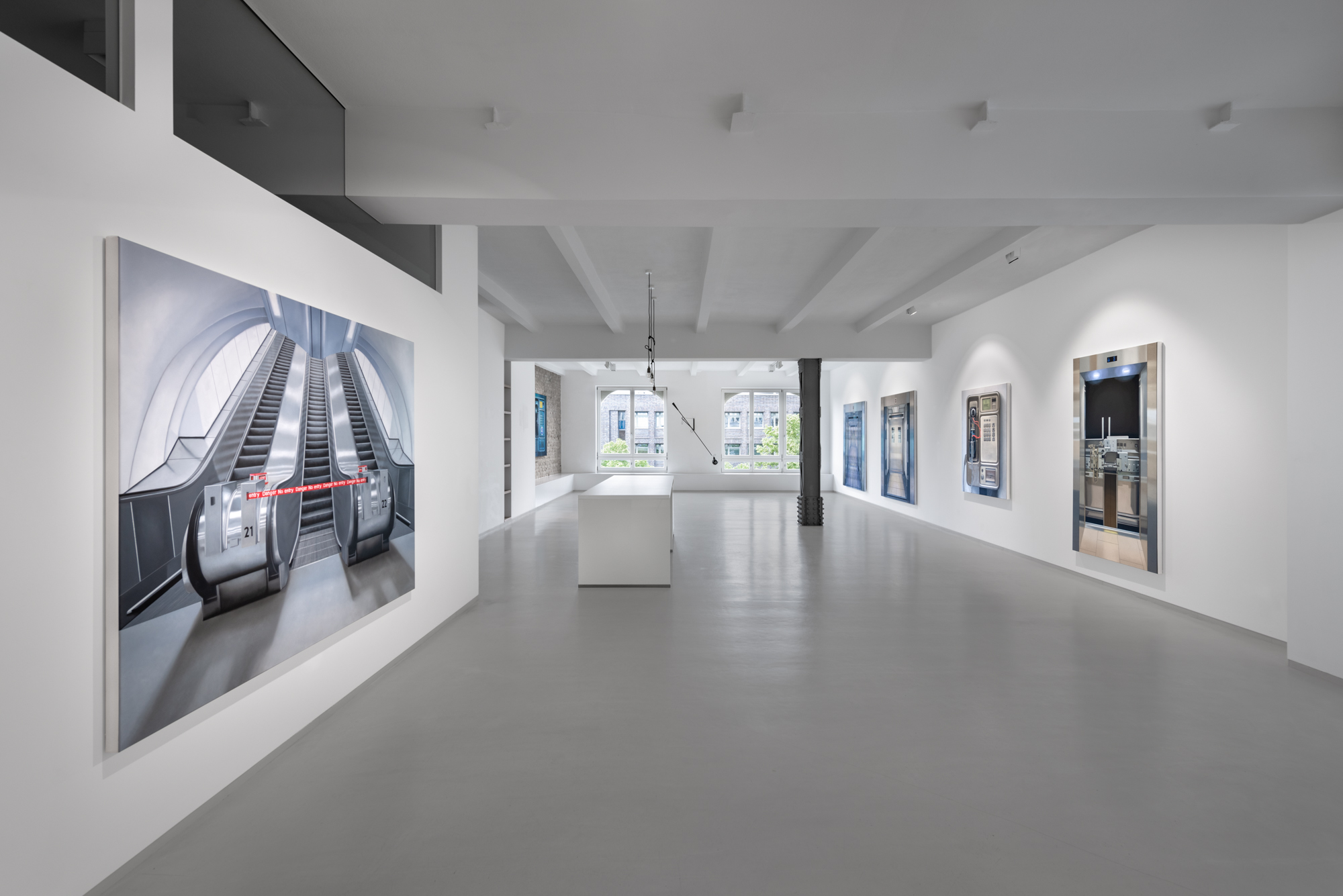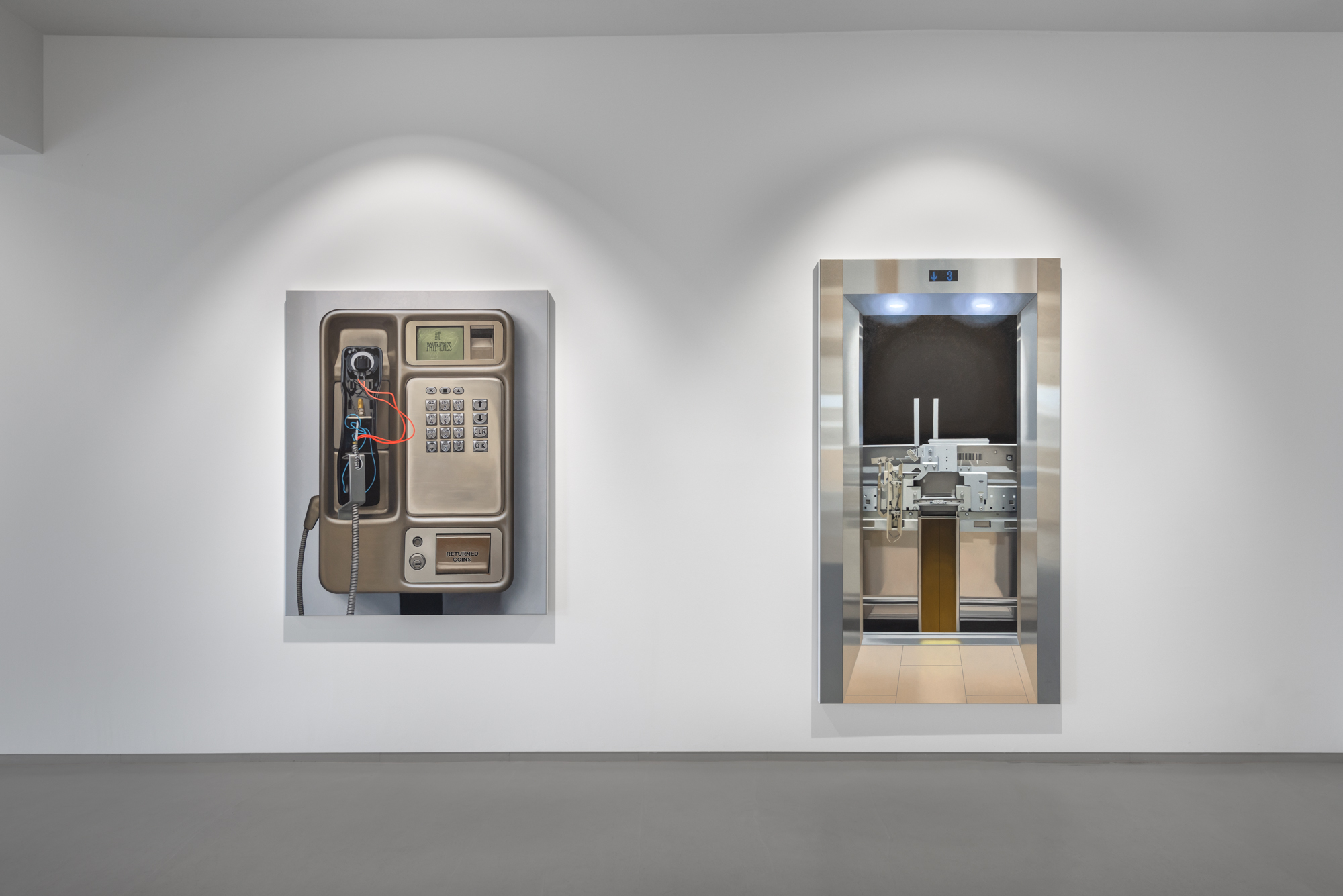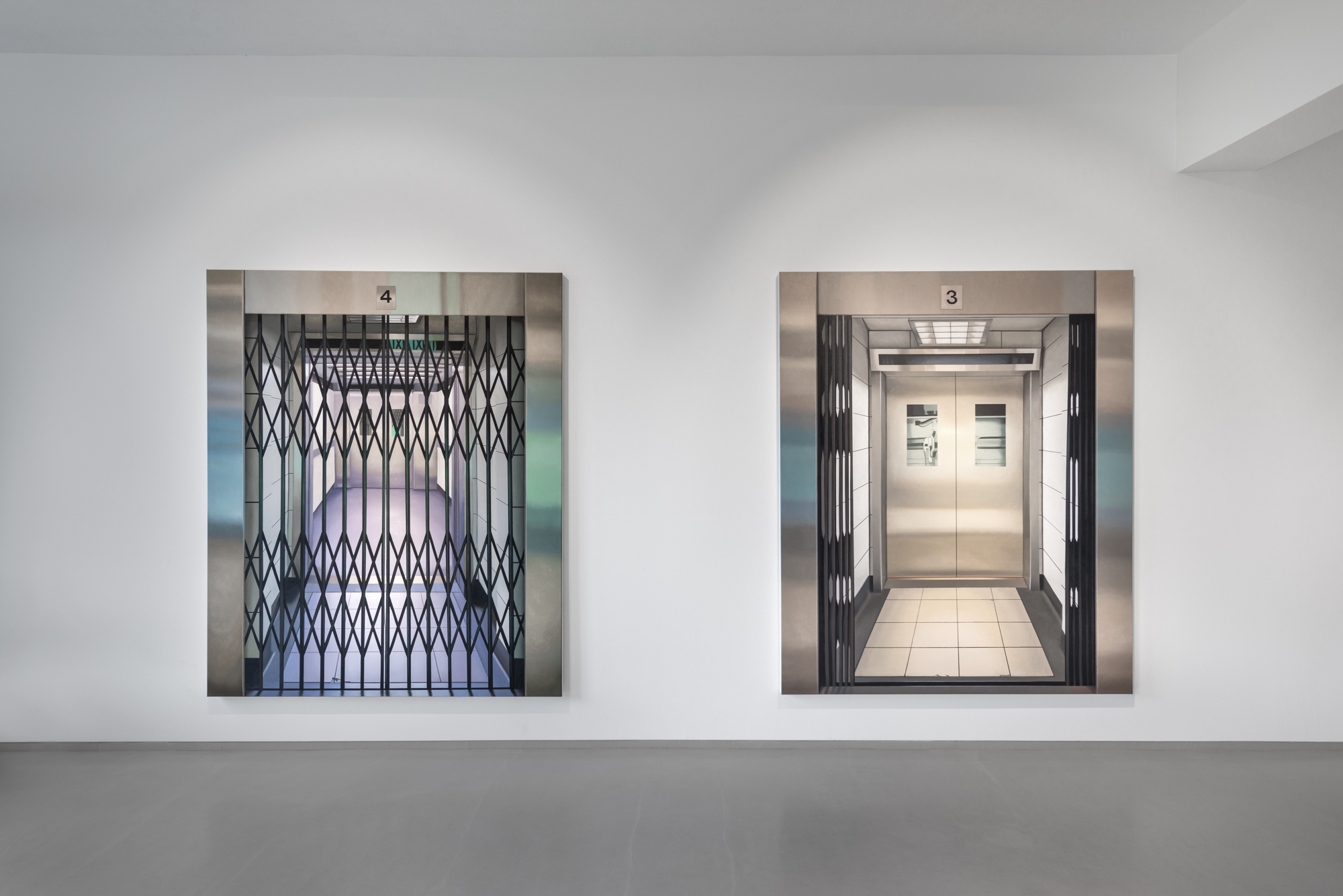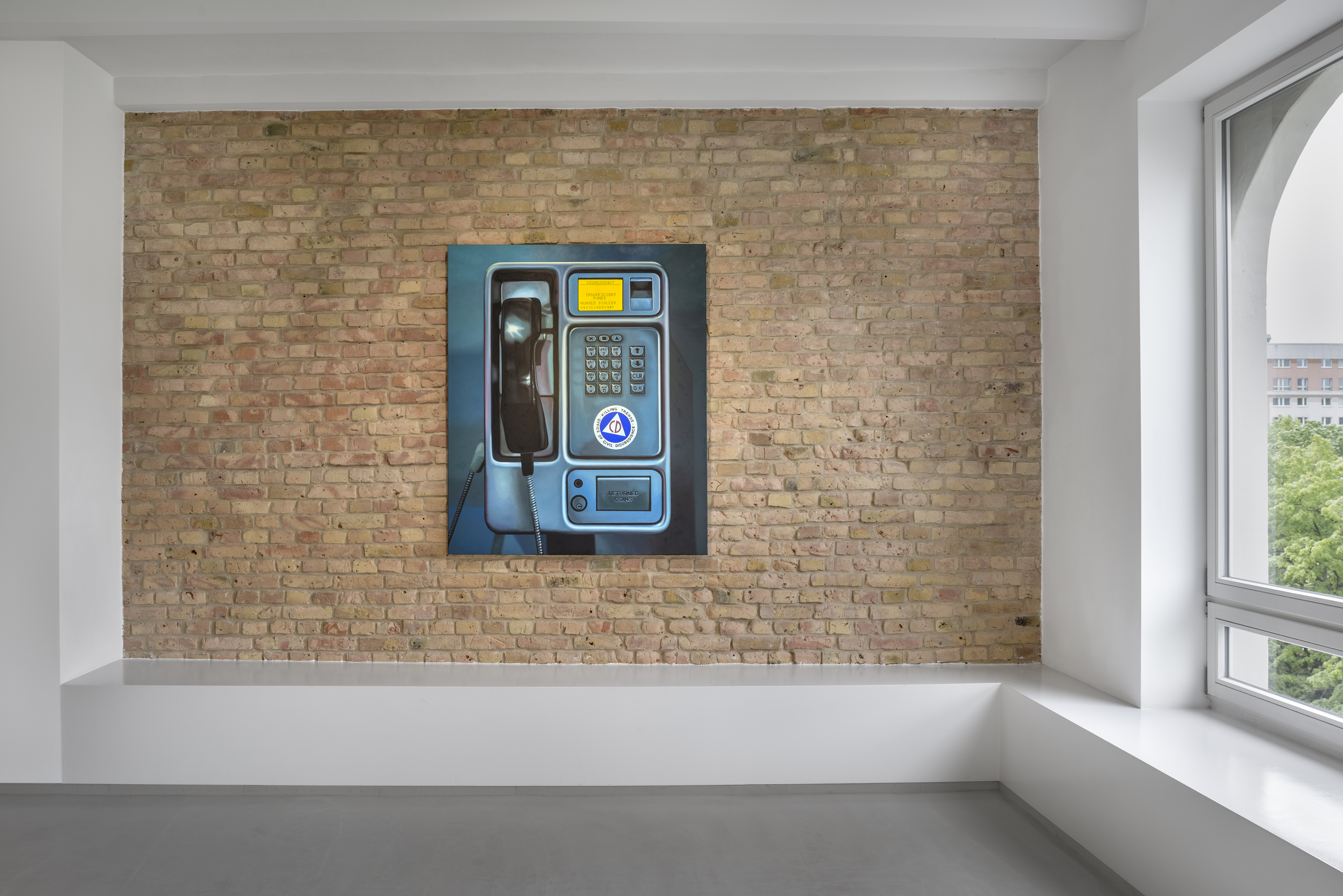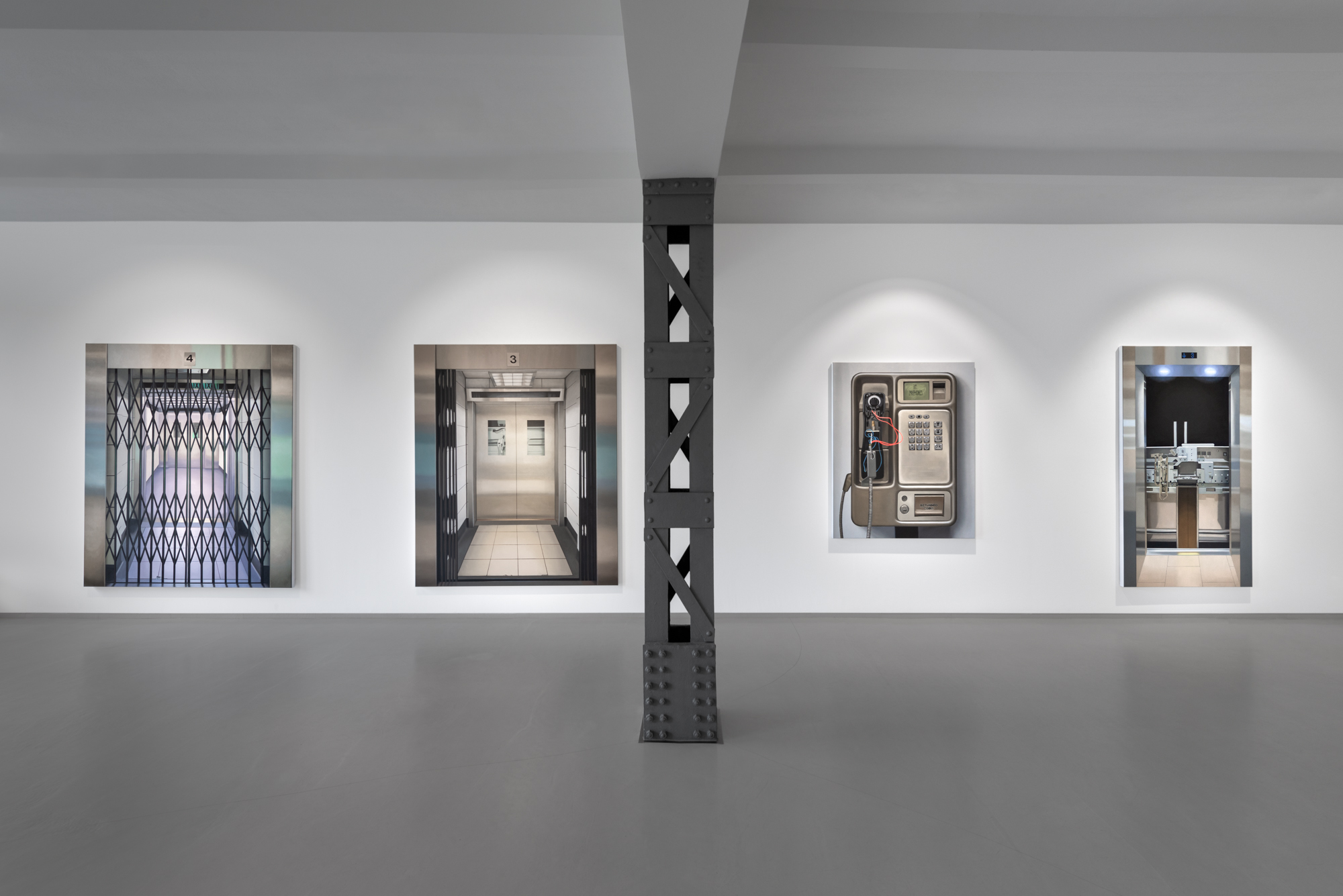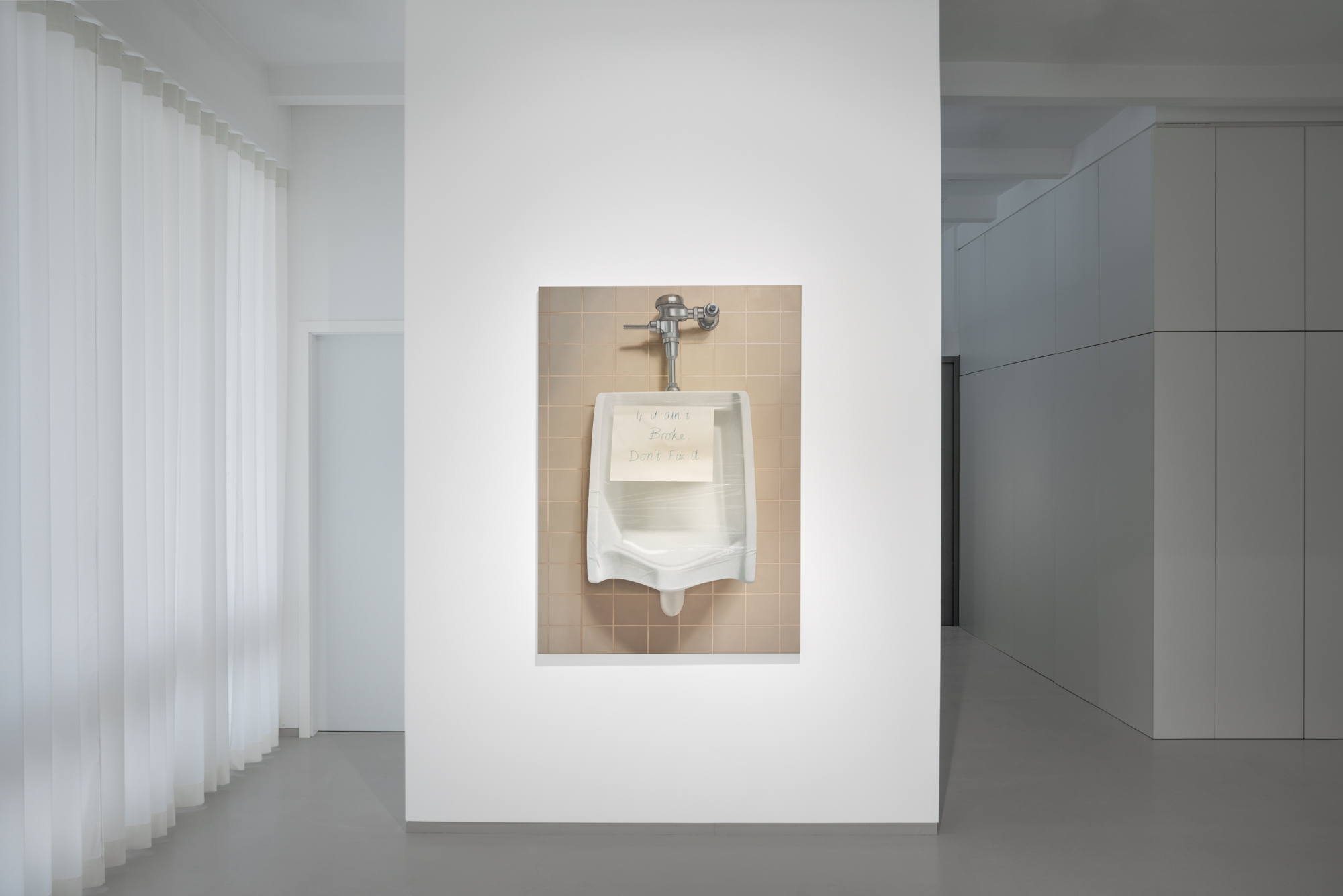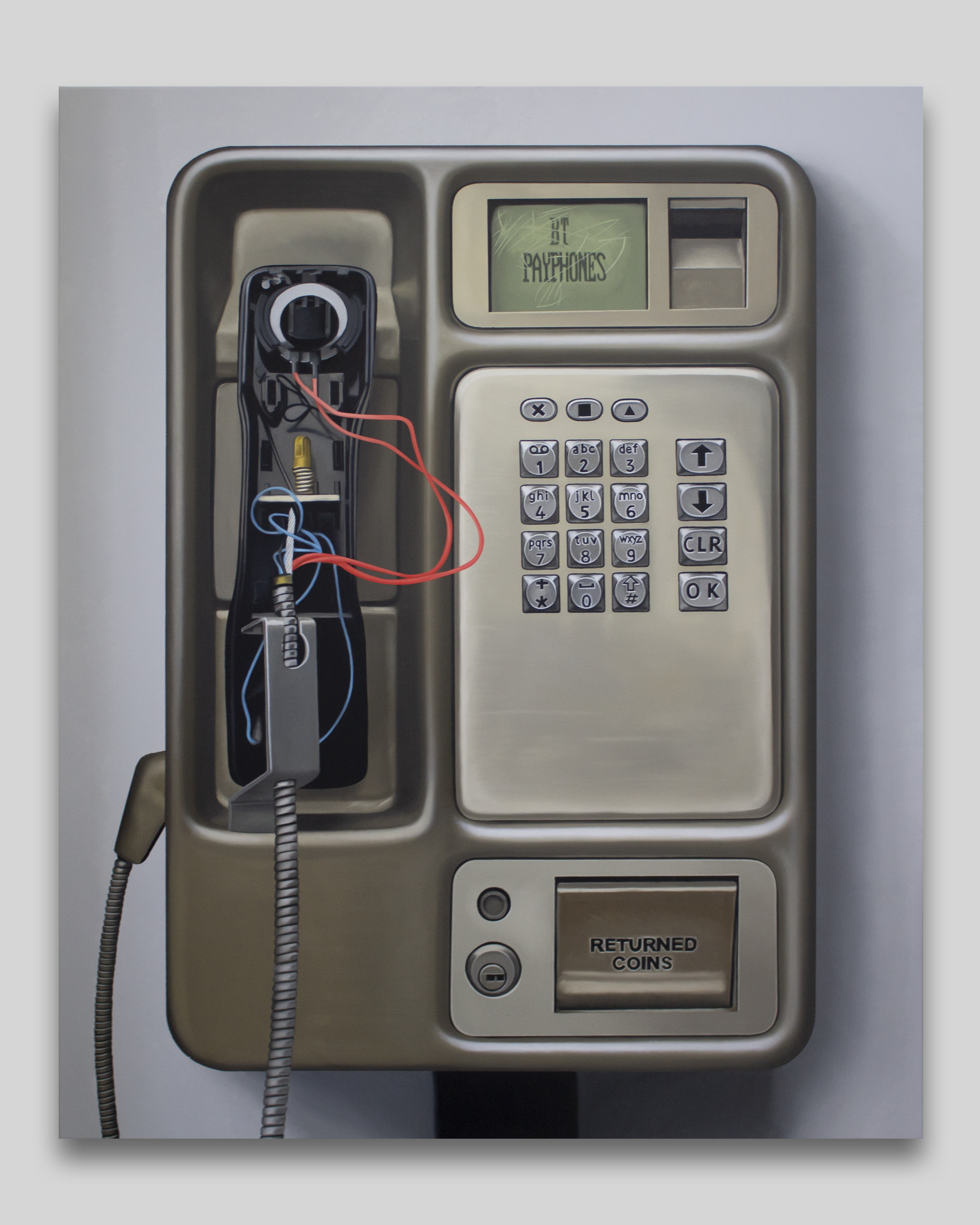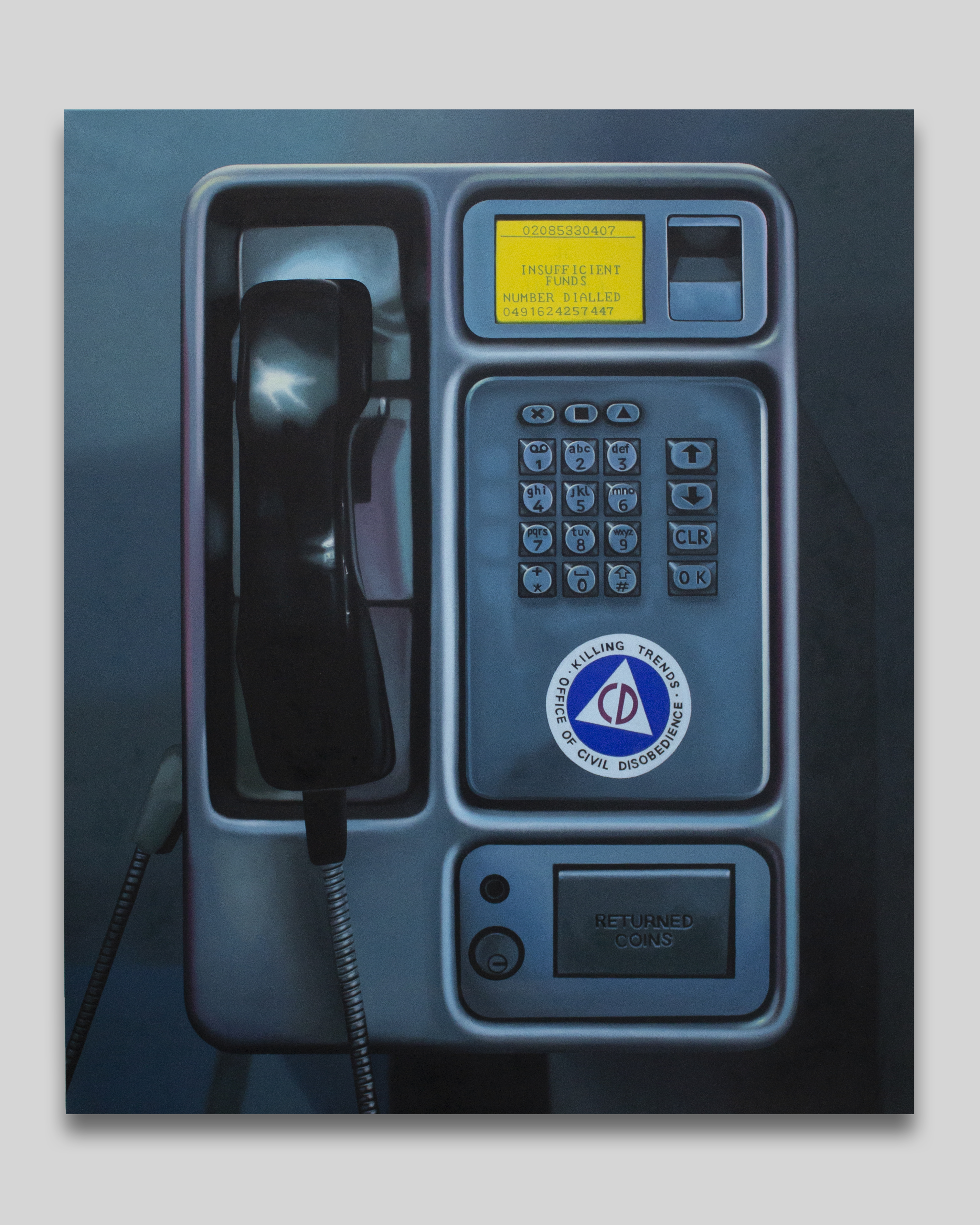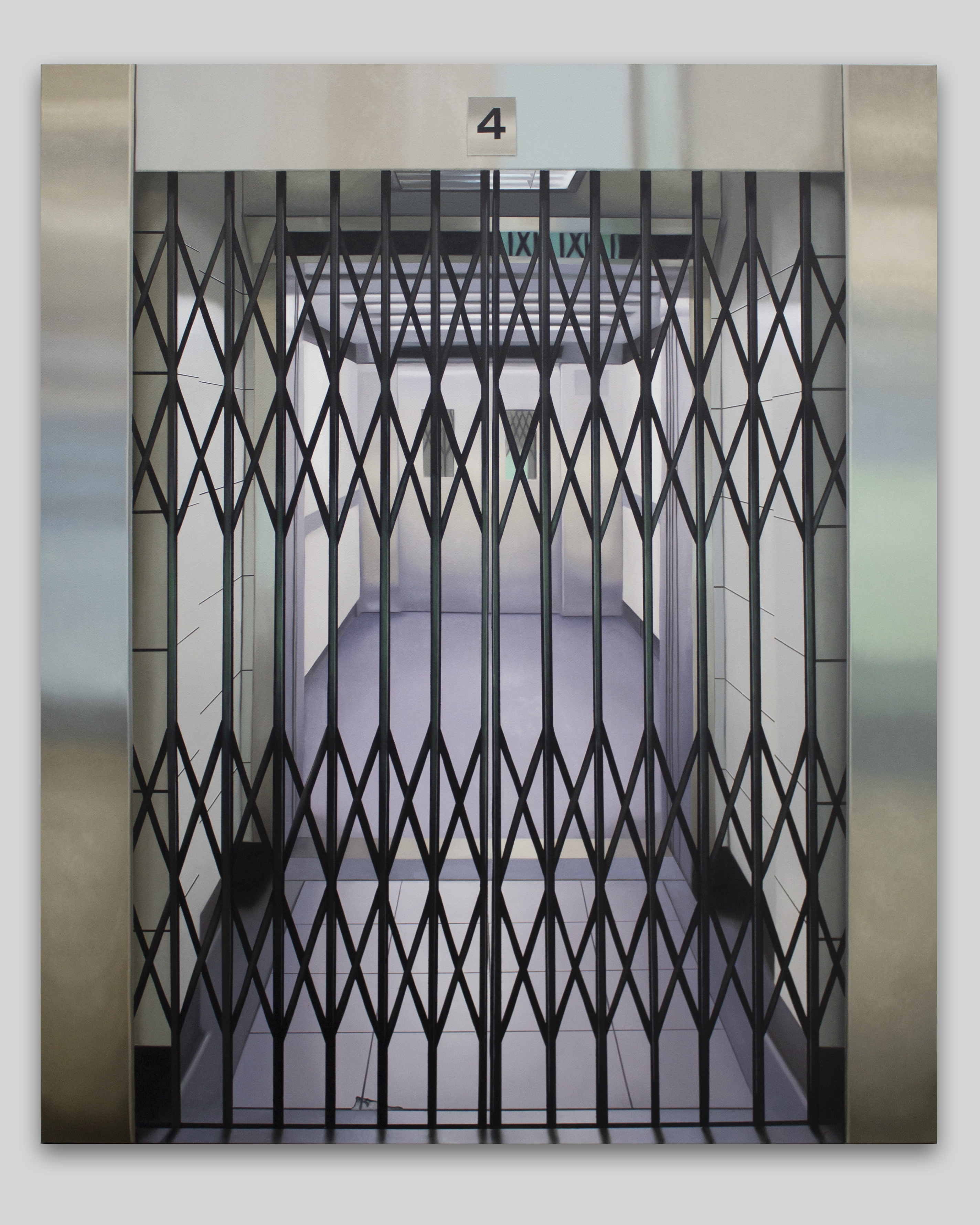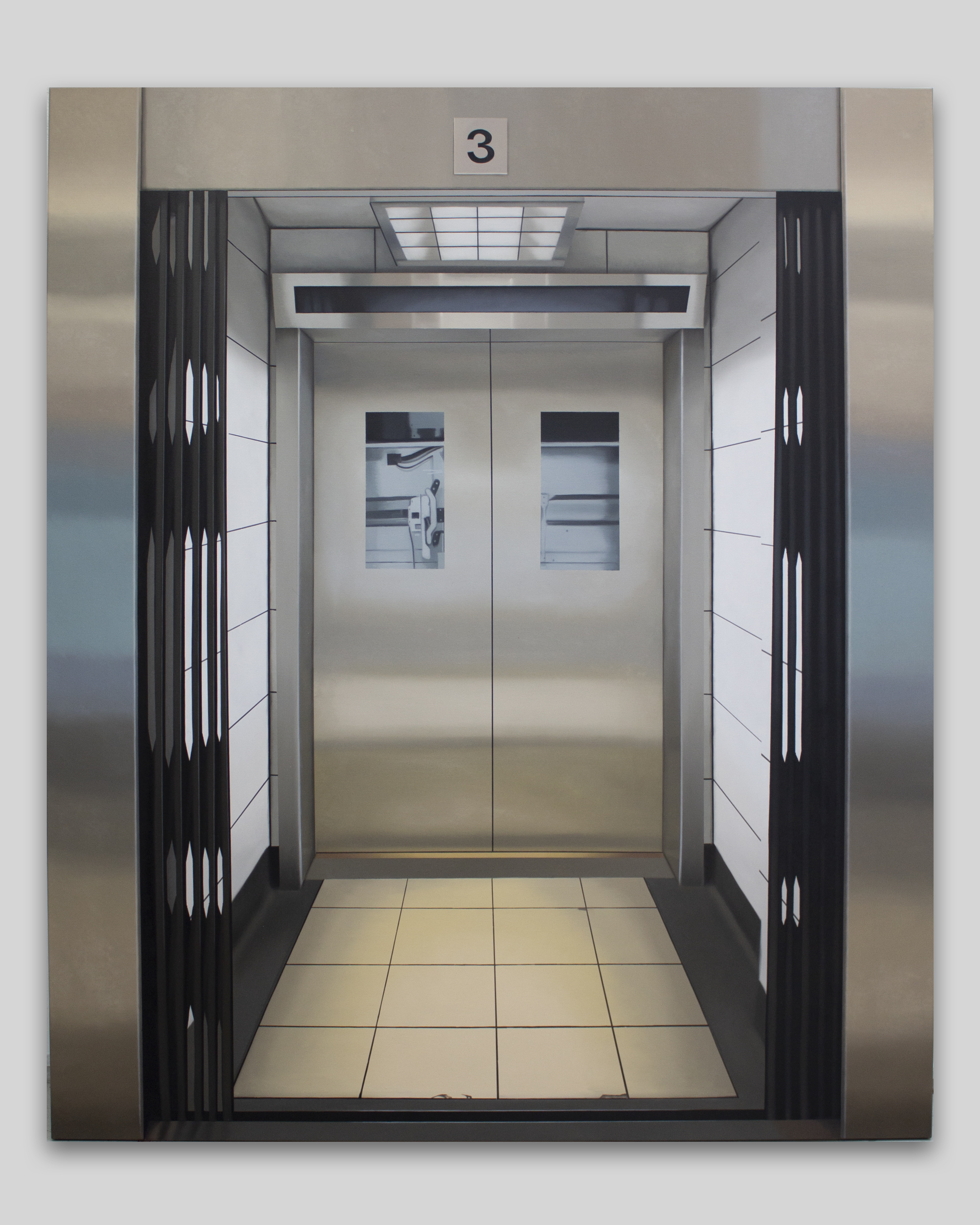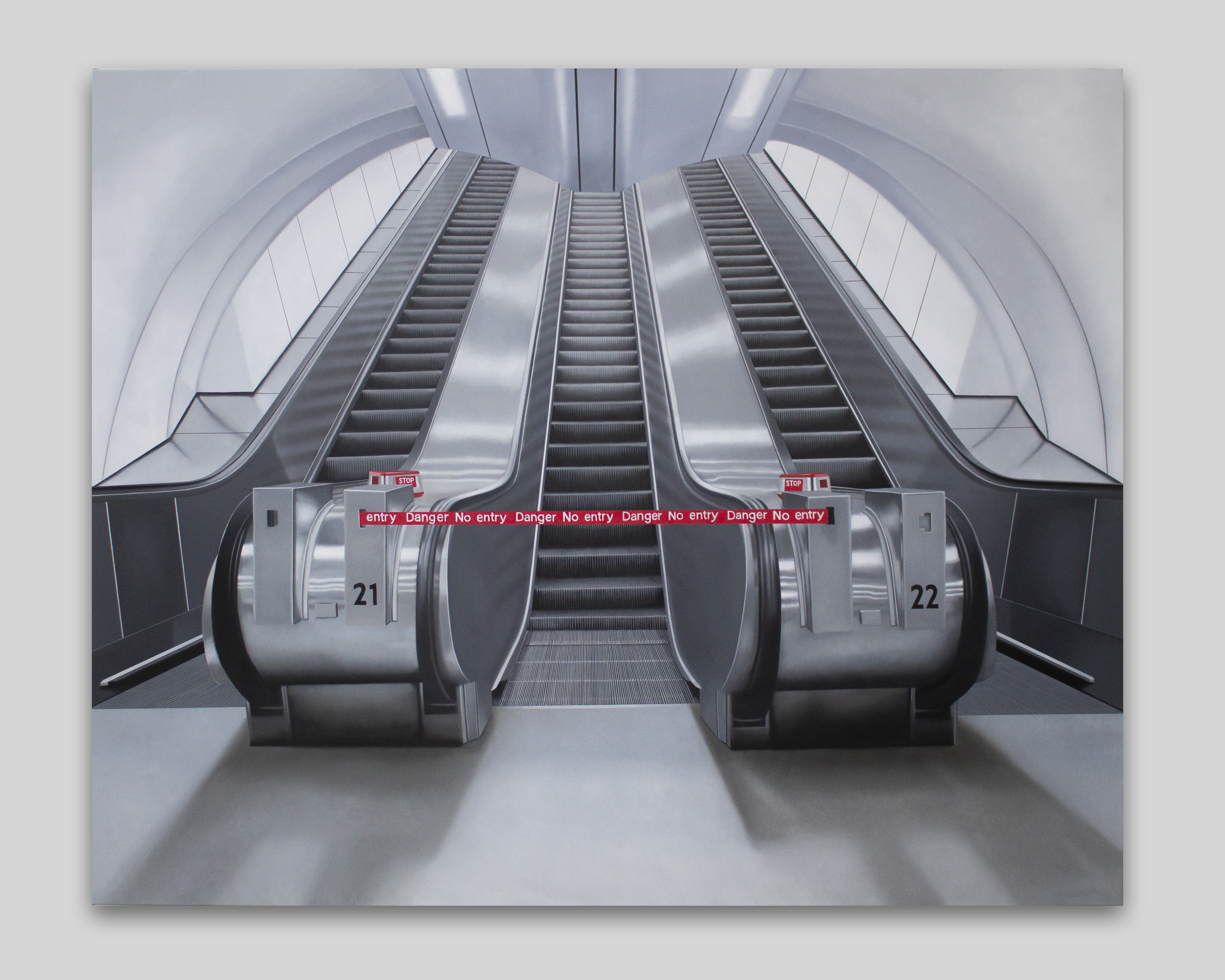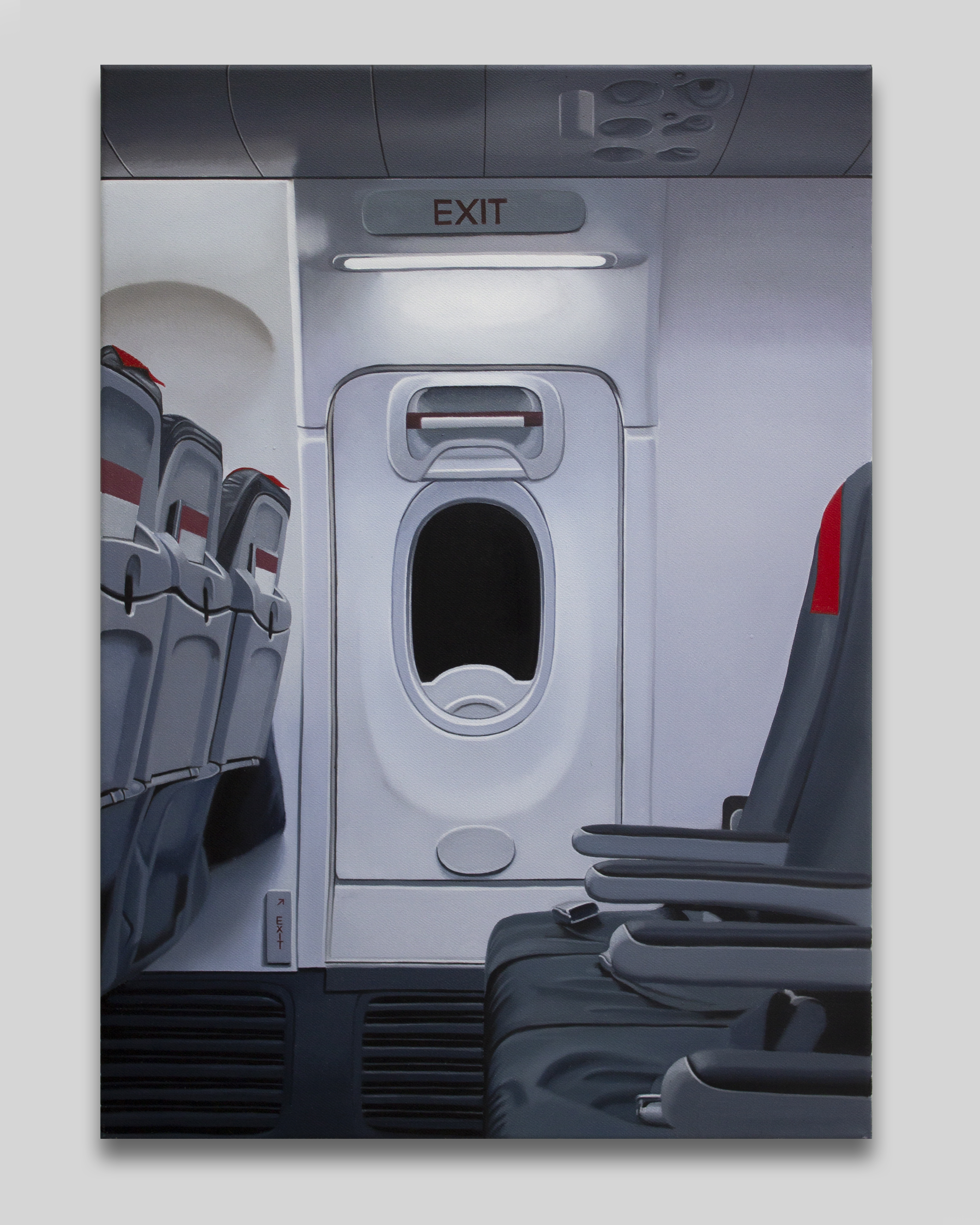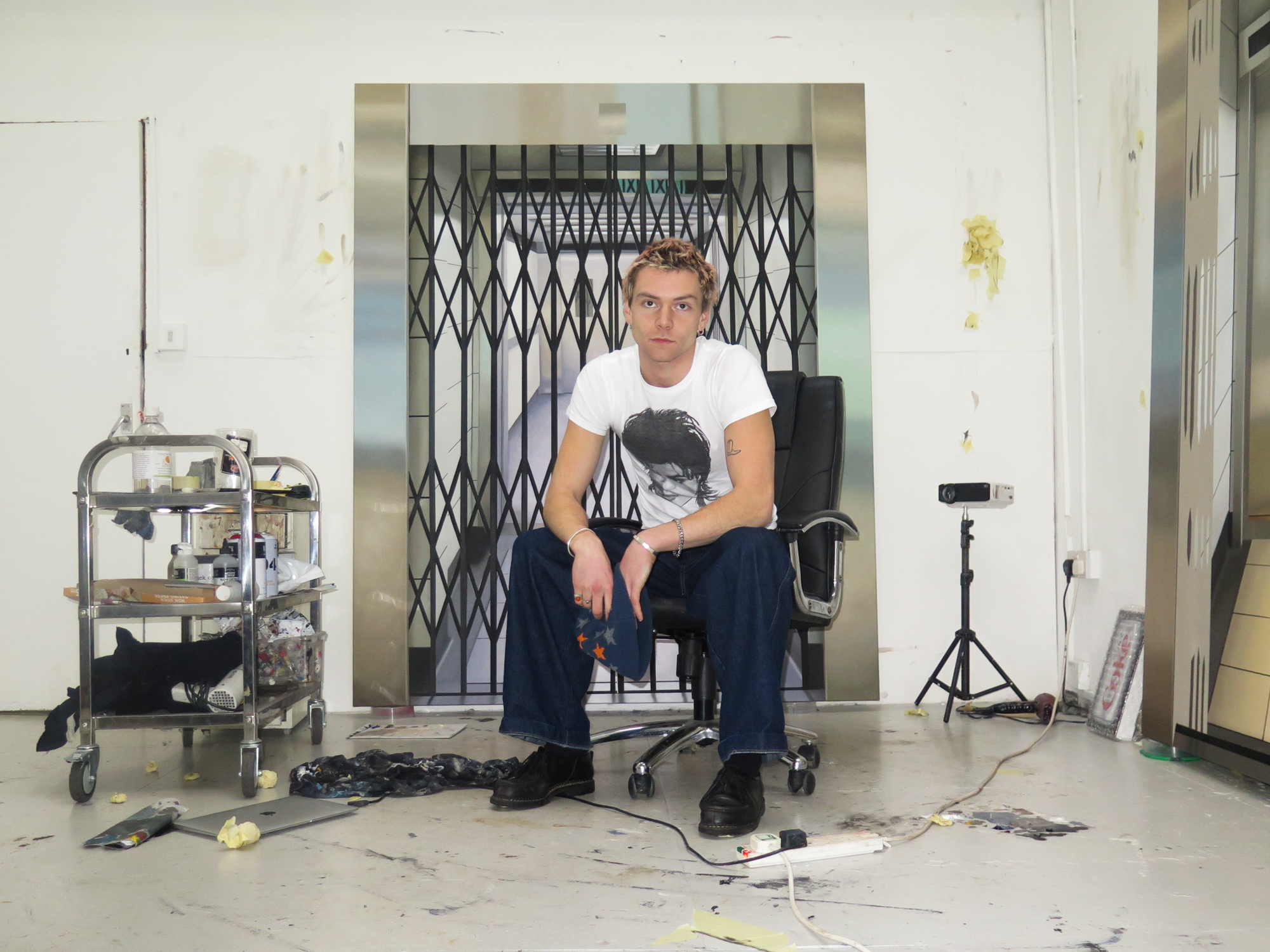CALLUM EATON
IMAGES
INFO
Callum Eaton
If it ain’t broke, don’t fix it
Callum Eaton makes slick, tantalising portraits of everyday objects that foreground the arrested freedom of late capitalist cities. Known for his sharp photorealism and an emblematic compulsion toward the visual language of overlooked urban infrastructure, Eaton’s work creates vivid, often parodic overtures to an increasingly digitised and transitory post-industrial world. Bringing together a new cycle of paintings composed primarily in London and in part during a six-week residency in Berlin operated by Better Go South, a contemporary art gallery based in Stuttgart, If it ain’t broke, don’t fix it is Eaton’s first solo exhibition with DUVE, Berlin, and includes his most ambitious series of paintings to date.
If it ain’t broke, don’t fix it features utilitarian city subjects not uncommon to Eaton’s practice: ATM machines, derelict payphones and public elevators, all rendered in luminous high- fidelity oil paint and coloured by contrasting – and at times conflicting – feelings of desire, dereliction and progress. These ‘readymade’ objects, flattened and aestheticized to a series of screens or perceptual portals, are symptomatic of the age we live in today: a frictionless, technology-driven and oversaturated world where realism has been pushed to a simulated extreme. Yet despite their familiarity, where these symbols once represented for Eaton the rapidly-advancing infrastructure of cities as a conveyor belt of progressive, technological obsolescence, here we are presented with their systemic civic and bureaucratic failure.
This shift is felt immediately in the tone of Eaton’s palette. In contrast to trompe-l’œil depictions of colourful self-service photo-booths or payphone doors pasted with McDonalds advertising, such as those shown in 2023 at Carl Kostyal and Hannah Barry Gallery respectively, the imagery in If it ain’t broke, don’t fix it has a melancholic and sombre tone. The near- monochrome steel blue and umber colourways of his vacant modern scenery is cold and alienating; ghostly, photographic even. Like a series of digitally-enhanced grisaille, Eaton’s malfunctioning objects – including out of order urinals, dilapidated lifts and defunct payphones – shutter between images of relics and the image as relic, calling to mind the vernacular of black-and-white archival imagery used in
museological catalogues as much as the architectural sculptural negatives of Rachel Whiteread.
For not only does the content of Eaton’s imagery appear ghostly – removed as they are from any specificity of space, place or time – it is the very ideas which sustain those images that are for Eaton also slowly petrifying: democratic urbanism, social mobility, frictionless global travel and digital exchange.
The inability of to connect with and through technological devices that have become either disposable or defective creates an acute sense of emotional distance, disaffection and frustration. Eaton’s illusionistic paintings demand to be
scrutinised closely, and yet as one does so, the images dissolve not only into abstract gradations of tone, figure and ground collapsing into the flatness of the surface, but mirages of 20th century liberal capitalist ideals.
It is no coincidence there is no human presence in the paintings. The closest we come to a subject is a failed ATM transaction bearing the artists’ own name – a tongue-in-cheek allusion to the Renaissance maxim that ‘every painter paints himself’ – that subtly positions the viewer in an animating tension between first-person subject of the scene (the paintings themselves are eerily reminiscent of contemporary POV video game graphics) and voyeur to Eaton’s own abstracted psychological landscape. Indeed, much like the eerie scenes of derelict suburban houses by British painter George Shaw, it is precisely this lack of agency found in Eaton’s paintings that impresses on the viewer that the architectural, technological and material world we inhabit shapes us just as much as we shape it.
One could describe Eaton’s practice as ‘bearing witness’ to the shifting architectures of the city and its technological and material infrastructure. In this exhibition, Eaton pushes this poetics of seeing into a pensive and vexed dimension, softly political and attuned to the anonymity and affective longing many of us feel living in contemporary urban landscapes. Each painting is a confrontation with the inevitable passing of time, with questions of public and civic space, of everyday beauty and legacies of both realist and abstract painting. The use of the titular proverb, If it ain’t broke, don’t fix, stands as an ambiguous and apprehensive statement, both apathetic and satirical, mundane and subversively evocative.
— Charlie Mills
Callum Eaton (b. 1997 Bath, UK) lives and works in London. Eaton graduated with a BA in Fine Art from Goldsmiths College, University of London, UK (2019). Solo exhibitions include Look but don’t touch, Carl Kostyal, London, UK (2023); and Hole in the Wall, Long Story Short Gallery, Paris, FR (2023). Selected group exhibitions include The Unlimited Dream Company II, Hannah Barry Gallery, London, UK (2023);
I DON’T NEED IT, BUT I WANT IT, The Office, Miami, US (2022); Breaking News, Another Gallery, Paris, FR (2022); The Call, Hackney Down Studios, London, UK (2021); and Morrison Foerster, The Scalpel, London (2021).
If it ain’t broke, don’t fix it
Callum Eaton makes slick, tantalising portraits of everyday objects that foreground the arrested freedom of late capitalist cities. Known for his sharp photorealism and an emblematic compulsion toward the visual language of overlooked urban infrastructure, Eaton’s work creates vivid, often parodic overtures to an increasingly digitised and transitory post-industrial world. Bringing together a new cycle of paintings composed primarily in London and in part during a six-week residency in Berlin operated by Better Go South, a contemporary art gallery based in Stuttgart, If it ain’t broke, don’t fix it is Eaton’s first solo exhibition with DUVE, Berlin, and includes his most ambitious series of paintings to date.
If it ain’t broke, don’t fix it features utilitarian city subjects not uncommon to Eaton’s practice: ATM machines, derelict payphones and public elevators, all rendered in luminous high- fidelity oil paint and coloured by contrasting – and at times conflicting – feelings of desire, dereliction and progress. These ‘readymade’ objects, flattened and aestheticized to a series of screens or perceptual portals, are symptomatic of the age we live in today: a frictionless, technology-driven and oversaturated world where realism has been pushed to a simulated extreme. Yet despite their familiarity, where these symbols once represented for Eaton the rapidly-advancing infrastructure of cities as a conveyor belt of progressive, technological obsolescence, here we are presented with their systemic civic and bureaucratic failure.
This shift is felt immediately in the tone of Eaton’s palette. In contrast to trompe-l’œil depictions of colourful self-service photo-booths or payphone doors pasted with McDonalds advertising, such as those shown in 2023 at Carl Kostyal and Hannah Barry Gallery respectively, the imagery in If it ain’t broke, don’t fix it has a melancholic and sombre tone. The near- monochrome steel blue and umber colourways of his vacant modern scenery is cold and alienating; ghostly, photographic even. Like a series of digitally-enhanced grisaille, Eaton’s malfunctioning objects – including out of order urinals, dilapidated lifts and defunct payphones – shutter between images of relics and the image as relic, calling to mind the vernacular of black-and-white archival imagery used in
museological catalogues as much as the architectural sculptural negatives of Rachel Whiteread.
For not only does the content of Eaton’s imagery appear ghostly – removed as they are from any specificity of space, place or time – it is the very ideas which sustain those images that are for Eaton also slowly petrifying: democratic urbanism, social mobility, frictionless global travel and digital exchange.
The inability of to connect with and through technological devices that have become either disposable or defective creates an acute sense of emotional distance, disaffection and frustration. Eaton’s illusionistic paintings demand to be
scrutinised closely, and yet as one does so, the images dissolve not only into abstract gradations of tone, figure and ground collapsing into the flatness of the surface, but mirages of 20th century liberal capitalist ideals.
It is no coincidence there is no human presence in the paintings. The closest we come to a subject is a failed ATM transaction bearing the artists’ own name – a tongue-in-cheek allusion to the Renaissance maxim that ‘every painter paints himself’ – that subtly positions the viewer in an animating tension between first-person subject of the scene (the paintings themselves are eerily reminiscent of contemporary POV video game graphics) and voyeur to Eaton’s own abstracted psychological landscape. Indeed, much like the eerie scenes of derelict suburban houses by British painter George Shaw, it is precisely this lack of agency found in Eaton’s paintings that impresses on the viewer that the architectural, technological and material world we inhabit shapes us just as much as we shape it.
One could describe Eaton’s practice as ‘bearing witness’ to the shifting architectures of the city and its technological and material infrastructure. In this exhibition, Eaton pushes this poetics of seeing into a pensive and vexed dimension, softly political and attuned to the anonymity and affective longing many of us feel living in contemporary urban landscapes. Each painting is a confrontation with the inevitable passing of time, with questions of public and civic space, of everyday beauty and legacies of both realist and abstract painting. The use of the titular proverb, If it ain’t broke, don’t fix, stands as an ambiguous and apprehensive statement, both apathetic and satirical, mundane and subversively evocative.
— Charlie Mills
Callum Eaton (b. 1997 Bath, UK) lives and works in London. Eaton graduated with a BA in Fine Art from Goldsmiths College, University of London, UK (2019). Solo exhibitions include Look but don’t touch, Carl Kostyal, London, UK (2023); and Hole in the Wall, Long Story Short Gallery, Paris, FR (2023). Selected group exhibitions include The Unlimited Dream Company II, Hannah Barry Gallery, London, UK (2023);
I DON’T NEED IT, BUT I WANT IT, The Office, Miami, US (2022); Breaking News, Another Gallery, Paris, FR (2022); The Call, Hackney Down Studios, London, UK (2021); and Morrison Foerster, The Scalpel, London (2021).
Callum Eaton fertigt raffinierte, verlockende Porträts von Alltagsgegenständen an, die die festgehaltene Freiheit der spätkapitalistischen Städte in den Vordergrund stellen. Bekannt für seinen scharfen Fotorealismus und seinen emblematischen Zwang zur visuellen Sprache der übersehenen städtischen Infrastruktur, schafft Eaton mit seinen Arbeiten lebendige, oft parodistische Ouvertüren zu einer zunehmend digitalisierten und vergänglichen postindustriellen Welt. *If it ain't broke, don't fix it* ist Eatons erste Einzelausstellung bei DUVE, Berlin, und umfasst seine bisher ehrgeizigste Gemäldeserie. Sie entstand hauptsächlich in London und zum Teil während eines sechswöchigen Aufenthalts in Berlin, der von der Stuttgarter Galerie Better Go South organisiert wurde.
*If it ain't broke, don't fix it* zeigt utilitaristische Stadtmotive, die für Eatons Praxis nicht unüblich sind: Geldautomaten, heruntergekommene Münztelefone und öffentliche Aufzüge, die alle mit leuchtender, originalgetreuer Ölfarbe bemalt sind und von kontrastierenden - und manchmal widersprüchlichen - Gefühlen von Verlangen, Verfall und Fortschritt geprägt sind. Diese "Readymade"-Objekte, die zu einer Reihe von Bildschirmen oder Wahrnehmungsportalen verflacht und ästhetisiert wurden, sind symptomatisch für das Zeitalter, in dem wir heute leben: eine reibungslose, technologiegetriebene und übersättigte Welt, in der der Realismus auf ein simuliertes Extrem getrieben wurde. Doch trotz ihrer Vertrautheit - wo diese Symbole für Eaton einst die schnell voranschreitende Infrastruktur der Städte als Fließband fortschreitender, technologischer Veralterung repräsentierten, wird uns hier ihr systemisches bürgerliches und bürokratisches Versagen vor Augen geführt.
Diese Veränderung ist unmittelbar im Ton von Eatons Palette zu spüren. Im Gegensatz zu Trompel'œil-Darstellungen von bunten Selbstbedienungs-Fotoautomaten oder mit McDonalds-Werbung beklebten Münztelefon-Türen, wie sie in 2023 bei Carl Kostyal bzw. in der Hannah Barry Gallery zu sehen waren, hat die Bildsprache in If it ain't broke, don't fix it einen melancholischen und düsteren Ton. Die fast monochromen stahlblauen und umberfarbenen Farben seiner leeren, modernen Szenerie wirken kalt und befremdlich, geisterhaft, sogar fotografisch. Wie eine Reihe von digital verbesserten Grisaille-Bildern schwanken Eatons funktionsuntüchtige Objekte - darunter defekte Pissoirs, baufällige Aufzüge und stillgelegte Münztelefone - zwischen Bildern von Relikten und dem Bild als Relikt und erinnern an die in musealen Katalogen verwendeten schwarz-weißen Archivbilder ebenso wie an die architektonischen Skulpturnegative von Rachel Whiteread.
Denn nicht nur der Inhalt von Eatons Bildern erscheint geisterhaft - losgelöst von jeglicher Spezifität des Raums, des Ortes oder der Zeit - es sind auch die Ideen, die diese Bilder tragen, die für Eaton langsam versteinern: demokratischer Urbanismus, soziale Mobilität, reibungsloses globales Reisen und digitaler Austausch. Die Unfähigkeit, sich mit und durch technologische Geräte zu verbinden, die entweder wegwerfbar oder defekt geworden sind, schafft ein akutes Gefühl von emotionaler Distanz, Entfremdung und Frustration. Eatons illusionistische Gemälde verlangen nach einer genauen Betrachtung, doch wenn man dies tut, lösen sich die Bilder nicht nur in abstrakte Tonabstufungen auf, sondern auch in Trugbilder der liberalen kapitalistischen Ideale des 20. Jahrhunderts
Es ist kein Zufall, dass auf den Gemälden kein Mensch zu sehen ist. Am nächsten kommen wir einem Subjekt, nämlich einer fehlgeschlagenen Geldautomatentransaktion, die den Namen des Künstlers trägt - eine augenzwinkernde Anspielung auf die Maxime der Renaissance, dass "jeder Maler sich selbst malt" -, die den Betrachter auf subtile Weise in eine belebende Spannung zwischen dem Ich-Subjekt der Szene (die Gemälde selbst erinnern auf unheimliche Weise an zeitgenössische POV-Videospielgrafiken) und dem Voyeur von Eatons eigener abstrahierter psychologischer Landschaft versetzt.Ähnlich wie bei den unheimlichen Szenen verfallener Vorstadthäuser des britischen Malers George Shaw ist es genau dieser Mangel an Handlungsfähigkeit in Eatons Bildern, der dem Betrachter vor Augen führt, dass die architektonische, technologische und materielle Welt, in der wir leben, uns ebenso formt wie wir sie formen.
Man könnte Eatons Praxis als "Zeugnis" für die sich wandelnden Architekturen der Stadt und ihrer technologischen und materiellen Infrastruktur beschreiben. In dieser Ausstellung treibt Eaton diese Poetik des Sehens in eine nachdenkliche und verwirrende Dimension, die sanft politisch ist und auf die Anonymität und affektive Sehnsucht abgestimmt ist, die viele von uns beim Leben in zeitgenössischen Stadtlandschaften empfinden. Jedes Bild ist eine Konfrontation mit dem unvermeidlichen Vergehen der Zeit, mit Fragen des öffentlichen und bürgerlichen Raums, der alltäglichen Schönheit und dem Erbe der realistischen und abstrakten Malerei. Die Verwendung des titelgebenden Sprichworts "If it ain't broke, don't fix" (Wenn es nicht kaputt ist, repariere es nicht) ist eine zweideutige und beunruhigende Aussage, die sowohl apathisch als auch satirisch, alltäglich und subversiv evokativ ist.
-Charlie Mills - (vom Englischen ins Deutsche übersetzt)
*If it ain't broke, don't fix it* zeigt utilitaristische Stadtmotive, die für Eatons Praxis nicht unüblich sind: Geldautomaten, heruntergekommene Münztelefone und öffentliche Aufzüge, die alle mit leuchtender, originalgetreuer Ölfarbe bemalt sind und von kontrastierenden - und manchmal widersprüchlichen - Gefühlen von Verlangen, Verfall und Fortschritt geprägt sind. Diese "Readymade"-Objekte, die zu einer Reihe von Bildschirmen oder Wahrnehmungsportalen verflacht und ästhetisiert wurden, sind symptomatisch für das Zeitalter, in dem wir heute leben: eine reibungslose, technologiegetriebene und übersättigte Welt, in der der Realismus auf ein simuliertes Extrem getrieben wurde. Doch trotz ihrer Vertrautheit - wo diese Symbole für Eaton einst die schnell voranschreitende Infrastruktur der Städte als Fließband fortschreitender, technologischer Veralterung repräsentierten, wird uns hier ihr systemisches bürgerliches und bürokratisches Versagen vor Augen geführt.
Diese Veränderung ist unmittelbar im Ton von Eatons Palette zu spüren. Im Gegensatz zu Trompel'œil-Darstellungen von bunten Selbstbedienungs-Fotoautomaten oder mit McDonalds-Werbung beklebten Münztelefon-Türen, wie sie in 2023 bei Carl Kostyal bzw. in der Hannah Barry Gallery zu sehen waren, hat die Bildsprache in If it ain't broke, don't fix it einen melancholischen und düsteren Ton. Die fast monochromen stahlblauen und umberfarbenen Farben seiner leeren, modernen Szenerie wirken kalt und befremdlich, geisterhaft, sogar fotografisch. Wie eine Reihe von digital verbesserten Grisaille-Bildern schwanken Eatons funktionsuntüchtige Objekte - darunter defekte Pissoirs, baufällige Aufzüge und stillgelegte Münztelefone - zwischen Bildern von Relikten und dem Bild als Relikt und erinnern an die in musealen Katalogen verwendeten schwarz-weißen Archivbilder ebenso wie an die architektonischen Skulpturnegative von Rachel Whiteread.
Denn nicht nur der Inhalt von Eatons Bildern erscheint geisterhaft - losgelöst von jeglicher Spezifität des Raums, des Ortes oder der Zeit - es sind auch die Ideen, die diese Bilder tragen, die für Eaton langsam versteinern: demokratischer Urbanismus, soziale Mobilität, reibungsloses globales Reisen und digitaler Austausch. Die Unfähigkeit, sich mit und durch technologische Geräte zu verbinden, die entweder wegwerfbar oder defekt geworden sind, schafft ein akutes Gefühl von emotionaler Distanz, Entfremdung und Frustration. Eatons illusionistische Gemälde verlangen nach einer genauen Betrachtung, doch wenn man dies tut, lösen sich die Bilder nicht nur in abstrakte Tonabstufungen auf, sondern auch in Trugbilder der liberalen kapitalistischen Ideale des 20. Jahrhunderts
Es ist kein Zufall, dass auf den Gemälden kein Mensch zu sehen ist. Am nächsten kommen wir einem Subjekt, nämlich einer fehlgeschlagenen Geldautomatentransaktion, die den Namen des Künstlers trägt - eine augenzwinkernde Anspielung auf die Maxime der Renaissance, dass "jeder Maler sich selbst malt" -, die den Betrachter auf subtile Weise in eine belebende Spannung zwischen dem Ich-Subjekt der Szene (die Gemälde selbst erinnern auf unheimliche Weise an zeitgenössische POV-Videospielgrafiken) und dem Voyeur von Eatons eigener abstrahierter psychologischer Landschaft versetzt.Ähnlich wie bei den unheimlichen Szenen verfallener Vorstadthäuser des britischen Malers George Shaw ist es genau dieser Mangel an Handlungsfähigkeit in Eatons Bildern, der dem Betrachter vor Augen führt, dass die architektonische, technologische und materielle Welt, in der wir leben, uns ebenso formt wie wir sie formen.
Man könnte Eatons Praxis als "Zeugnis" für die sich wandelnden Architekturen der Stadt und ihrer technologischen und materiellen Infrastruktur beschreiben. In dieser Ausstellung treibt Eaton diese Poetik des Sehens in eine nachdenkliche und verwirrende Dimension, die sanft politisch ist und auf die Anonymität und affektive Sehnsucht abgestimmt ist, die viele von uns beim Leben in zeitgenössischen Stadtlandschaften empfinden. Jedes Bild ist eine Konfrontation mit dem unvermeidlichen Vergehen der Zeit, mit Fragen des öffentlichen und bürgerlichen Raums, der alltäglichen Schönheit und dem Erbe der realistischen und abstrakten Malerei. Die Verwendung des titelgebenden Sprichworts "If it ain't broke, don't fix" (Wenn es nicht kaputt ist, repariere es nicht) ist eine zweideutige und beunruhigende Aussage, die sowohl apathisch als auch satirisch, alltäglich und subversiv evokativ ist.
-Charlie Mills - (vom Englischen ins Deutsche übersetzt)

